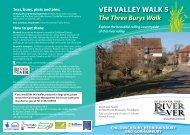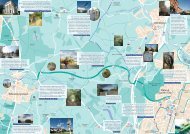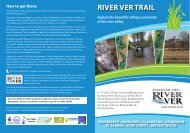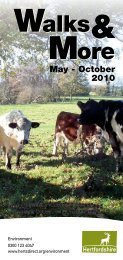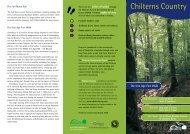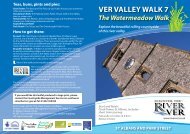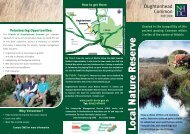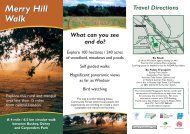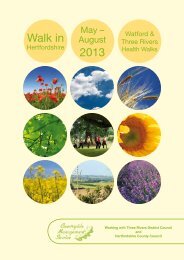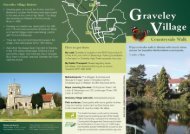Ver Valley Walk 8 - The Confluence Walk
Ver Valley Walk 8 - The Confluence Walk
Ver Valley Walk 8 - The Confluence Walk
Create successful ePaper yourself
Turn your PDF publications into a flip-book with our unique Google optimized e-Paper software.
Discover the River <strong>Ver</strong><br />
<strong>The</strong> River <strong>Ver</strong> is special; it is a chalk<br />
stream, one of only about 200 on<br />
the planet and its pure alkaline water<br />
supports a very particular mix of flora<br />
and fauna. For 450,000 years, since the<br />
Anglian Ice Age, it has flowed (almost)<br />
uninterrupted along its valley, south<br />
from its source at Kensworth Lynch in<br />
the Chiltern Hills, through Markyate,<br />
Flamstead, Redbourn, St Albans and Park<br />
Street to where it joins with the River<br />
Colne near Bricket Wood – ultimately<br />
to empty into the River Thames near<br />
Windsor.<br />
Man has used the river for navigation,<br />
for milling, for mineral extraction and<br />
for food production – these processes<br />
mean the river is much changed from its<br />
‘natural’ state. Today we utilise the <strong>Ver</strong> in<br />
two other ways. Firstly, deep boreholes<br />
into the chalk strata (or aquifer) abstract<br />
over half of all the water that falls as rain<br />
in the area. Secondly, we use the river<br />
and its attractive surroundings for simple<br />
leisure and pleasure, by walking through<br />
its valley or along its banks, as you might<br />
do today by following this route.<br />
Like a good book, the River <strong>Ver</strong> has<br />
a beginning, middle and end, and<br />
associated with its twists and turns<br />
many characters come and go; through<br />
these walks you will follow the story<br />
in eight chapters, from source to<br />
confluence. We aim to set the <strong>Ver</strong> in its<br />
local landscape and cultural context. For<br />
further information about the <strong>Ver</strong> and<br />
the people who lived near it, past and<br />
present, visit our website: www.riverver.<br />
co.uk<br />
<strong>The</strong> River <strong>Ver</strong> links us to the past, present<br />
and future. It is...<br />
1<br />
5<br />
Moor Mill<br />
Moor Mill is mentioned in the Domesday<br />
Book. Before the Dissolution, Moremyll was a<br />
St Albans Abbey possession. From about 1400<br />
the Miller was asked to pay rent in the form of<br />
eels, caught in the waters around the mill, for<br />
the Abbey’s refectory.<br />
Hanstead House<br />
<strong>The</strong> Yule family purchased the house and<br />
estate in 1902. It was they who insisted that<br />
the nearby Colne <strong>Valley</strong> groundwater pumping<br />
stations were built in a rustic style.<br />
2 Park Street Bridge and ford<br />
A ford through the River <strong>Ver</strong> has existed here<br />
for at least 2,000 years. Nowadays the modern<br />
Watling Street/A5183 crosses on a sturdy<br />
bridge. <strong>The</strong> old Roman ford or ‘watersplash’<br />
can still be seen on its downstream side.<br />
<strong>The</strong> sand and gravel bands in Hertfordshire<br />
lie in the ‘Vale of St Albans’. This was the<br />
course of the proto-Thames which flowed<br />
approximately 2 million years ago out<br />
into the North Sea further north than<br />
the Thames does today. <strong>The</strong> bands of<br />
aggregate which overlay the chalk aquifer<br />
were deposited in vast quantities by the<br />
action of this river washed down from the<br />
Midlands. <strong>The</strong> last Ice Age diverted the<br />
Thames and <strong>Ver</strong> to their present courses.<br />
From Roman times this aggregate began<br />
to be utilised for building purposes: Sand<br />
and gravel for mortar, cement, ballast etc<br />
and flint for walls. In the 19th century, due<br />
to the Industrial Revolution and population<br />
increase, demand increased greatly. By the<br />
20th century modern machinery meant<br />
that mineral resources could be extracted<br />
on an industrial scale, this often resulted<br />
in the route and nature of the river being<br />
permanently altered, such as at Drop Lane.<br />
9<br />
Riverside Way<br />
20th century gravel extraction and subsequent<br />
‘restoration’ has greatly altered the <strong>Ver</strong>’s last<br />
mile. <strong>The</strong> river beside Drop Lane has been<br />
canalised and is a great place to see and catch<br />
Signal Crayfish.<br />
7 <strong>Confluence</strong> of the <strong>Ver</strong> with the<br />
Colne<br />
Oxford English Dictionary: ‘<strong>Confluence</strong>’ – a<br />
flowing together; the junction and union of<br />
two or more streams or moving fluids. <strong>The</strong><br />
place where two or more rivers, etc. unite.



